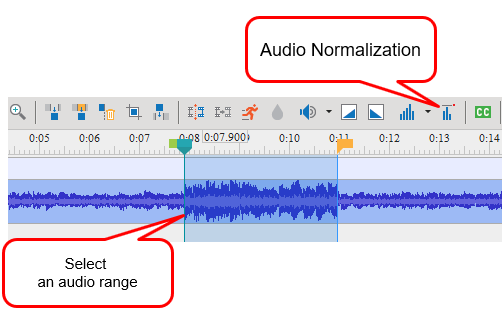Suppose you have a group of audio objects at different amplitudes and you want to make them all play at the same level. You can easily solve this issue by using the Audio Normalization feature in ActivePresenter 8. Basically, Audio Normalization applies a constant amount of gain to an audio recording to bring the amplitude to a target level (the norm). For example, you can normalize audio during the recording phase when you cannot speak at the same volume. So, let’s see how Audio Normalization works now.
Use Audio Normalization
Firstly, if you have an audio file and want to normalize it, ensure to insert it into ActivePresenter. After that, do as follows:
Step 1: Select the entire track or specify the audio range that you want to normalize.

Step 2: In the Timeline pane, click the Audio Normalization button . Then, the Audio Normalization dialog will appear as the below image. Adjust the settings and click OK to normalize the selected track.

Explore the dialog:
- Remove DC offset (center on 0.0 vertically): DC offset is an offsetting of a signal from zero. The waveform can represent the trouble as it appears above or below the 0.0 horizontal line. In general, DC offset is mostly a hardware problem that can cause clicks, distortion, or loss of audio volume, which can limit the possible loudness. Hence, removing DC offset is required when normalizing audio as it centers the waveform on the 0.0 amplitude level. Besides, if you are sure your audio has no offset, You should deselect this check box to speed up the normalization
- Normalize maximum amplitude to (peak normalization): Peak normalization brings the highest peak to the norm. A level of -1 dB (the initial default setting) is just below the maximum amplitude (0 dB) possible without clipping but gives a little headroom for effects and distortion-free playback on all equipment. For this option, enter zero or a negative value for the maximum amplitude you would like the selected track to have. A more negative value means you normalize the selected track to lower amplitudes.
- Normalize stereo channels independently: Normalization can work on the left and right channels of a stereo track as independently or as a pair. So, when you select this option, normalization adjusts the amplitude of the channels separately to the same peak level. This is handy for correcting stereo imbalances. In contrast, normalization adjusts the level of both channels by the same amount, which is practical if your audio is already balanced.
If you are not satisfied with the adjusting result, click Restore Defaults to go back to the original settings. Alternatively, press CTRL+Z on the keyboard. Then, try Audio Normalization again with different settings.
Final Word
So, you’ve known how to use Audio Normalization in ActivePresenter 8. Don’t forget to use this feature to enhance your audio quality. Hope that this helps.
See Also: